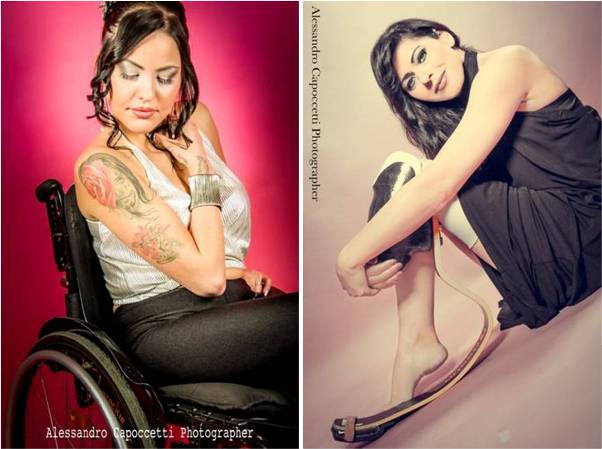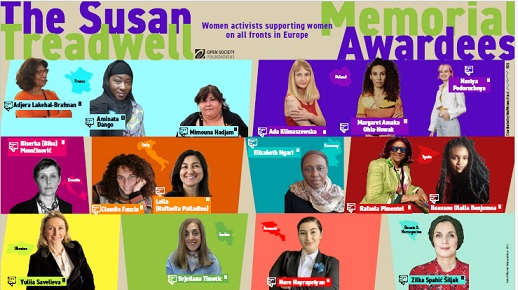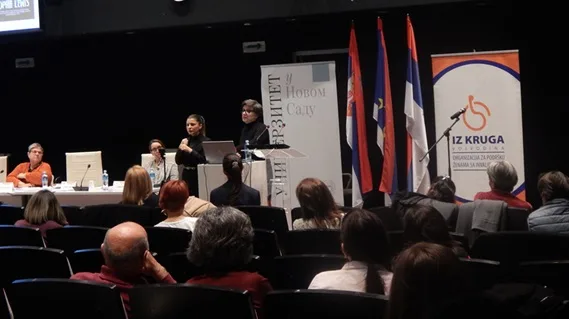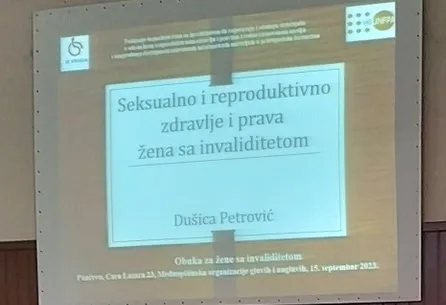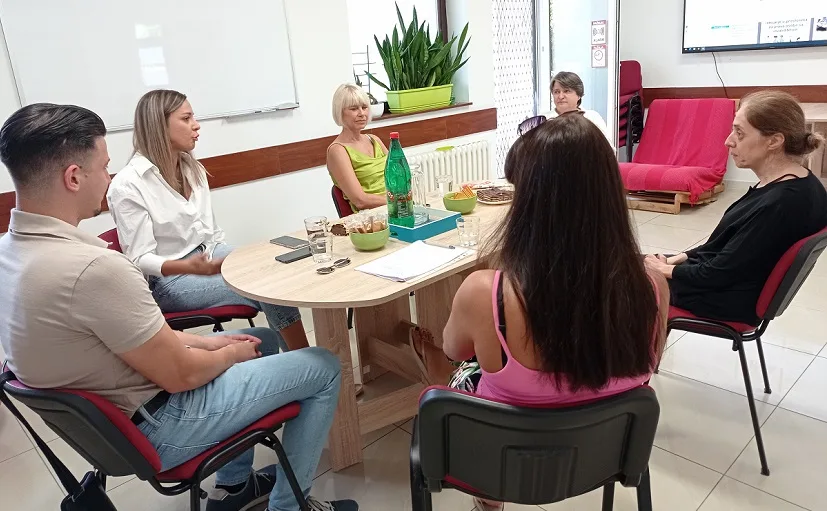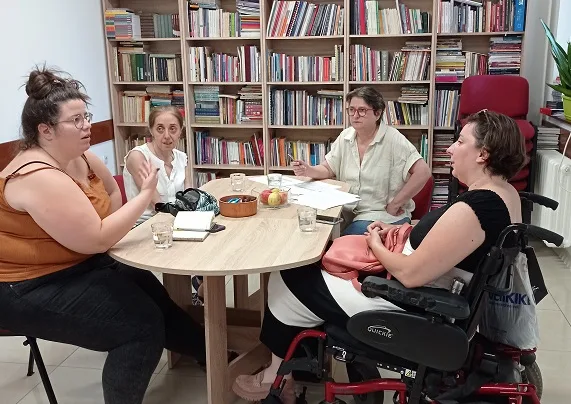 Alessandro Capoccetti is a professional photographer from Italy, who sometimes uses his prosthesis as a stand for the camera. He was born in 1979 in a village near Rome, with a rare syndrome Gollop-Wolfgang. The condition is characterized by underdevelopment of the tibia, and the lack of fingers and toes. As far as it’s known, there are only 200 people in the world with this condition and the cause of the syndrome remains unknown. From the early childhood Alessandro has been learning how to overcome challenges: – When you feel passion, even the biggest barriers become smaller. Although he studied music, photography has become his greatest passion. As a professional photographer, Alessandro travels a lot and he often stays in London. His work challenges the understanding of disability and body image, placing the viewer in front of the new standards of aesthetics and fashion.
Alessandro Capoccetti is a professional photographer from Italy, who sometimes uses his prosthesis as a stand for the camera. He was born in 1979 in a village near Rome, with a rare syndrome Gollop-Wolfgang. The condition is characterized by underdevelopment of the tibia, and the lack of fingers and toes. As far as it’s known, there are only 200 people in the world with this condition and the cause of the syndrome remains unknown. From the early childhood Alessandro has been learning how to overcome challenges: – When you feel passion, even the biggest barriers become smaller. Although he studied music, photography has become his greatest passion. As a professional photographer, Alessandro travels a lot and he often stays in London. His work challenges the understanding of disability and body image, placing the viewer in front of the new standards of aesthetics and fashion.
In the era and culture when the body is not a simple fact, but a source of dissatisfaction and the inevitable territory for chasing the imperfections, Alessandro reveals that we can not all be professional models, but certainly we can express beauty, regardless of size, color or the shape of the body. For him, the photography is looking from the heart – only then the lens can capture the essence of timeless beauty. Photography is expressive and artistic medium, but also a way to broaden the perception: the beauty, diversity, disability…
Describe yourself in three words.
Ideal, positive and stubborn.
What was the biggest turning point in your life?
A big turning point in my life was when I realized that my physical problems were my real strength. People admire my results and the way I deal with everyday problems. This pushes me to do better and better.
How did you become interested in photography?
I’ve started with photography when I met a woman photographer. I was 20 years old and I worked as a clerk in an Import-Export company. But I was tired of office life, which is very monotonous, so I left everything and started this new adventure; I opened a photo studio together with my friend. But after few years I went on my way, continuing my career as a professional photographer.
Do you remember your early works? What were they like? What was captured in the first photo you ever took?
My first photographs were taken in the street. Everyday life, stolen images in town life, much natural scenery… I love the harmony of the world around us.
You’re also a drum player. Do you somehow combine music and photography? Is there a cross-talk between rhythm and picture?
I started playing musical instruments when I was only nine, all thanks to my father, who was a music lover and a good musician. I think this has helped my formation of creativity and expression. Music is an instant means of communication as are the images; they come to the ear or to the eye with the same force and precision. Many times they make us understand and digest many feelings. Music and the image understood as a sign and sound, are, in the end, the first forms of expression that man has known to express himself.
Does disability influences your creative work? If yes, in which ways?
My disability affects my work a lot, in a positive way. I work hard with disabled models, thanks to the Models of Diversity campaign, and I think it is much easier to reach a state of feeling and synergy between photographer and models.
 Tell us more about Models of Diversity and your collaboration.
Tell us more about Models of Diversity and your collaboration.
I started working with Models of Diversity in 2010. Models of Diversity is a campaign for more diversity in the models we see every day. We call on the fashion, beauty and marketing industries to recognize the beauty in people of all races, ages, shapes, sizes, and abilities. Our mission is to change the face of fashion and modeling. Clearly, not just anyone can be a model; a successful model must have a special beauty, confidence, professionalism, ability to take direction, even artistic awareness. But no one with those talents should be excluded from the industry on arbitrary grounds. And no one should feel shut out from the modern presentation of beauty. Angel Sinclair, the founder of Models of Diversity is a former model herself. She founded the campaign after appearing on Gok’s Miss Naked Beauty in 2008. So we campaign at fashion events, hold street surveys, offer workshops and vigorously promote a more diverse range of models in the media and social networking.
What inspires you the most?
The thing that inspires me most is the inner beauty of people; I love trying to make it appear in my pictures.
Do you think photography can change societies’ views of disabled people?
I believe that I do not change the vision of people with disabilities with my photography, ‘cause I think it’s better to change the vision of all people by accustoming their eyes and their minds to looking at different forms of beauty and diversity. Breaking the barriers of mental prejudice.
How would you explain body diversity to someone from the other planet?
Maybe just let him know that, like me, I’m from another planet, lol…! Or maybe I would explain them rationally my physical diversity.
 Beauty has varied throughout time and cultures. What did you discover about it? What’s your personal definition of beauty?
Beauty has varied throughout time and cultures. What did you discover about it? What’s your personal definition of beauty?
Sometimes different models of Beauty coexist at the same time, while other models are invoked with each other through different ages. For example, two ideals of feminine beauty coexist in history: one is the model of the Greek Venus that prevails in our day, and the other is that of Paleolithic, fatty Venus, with big breasts and big buttocks. In the history of taste alternate round patterns (fertility symbols) and slimmer and slender patterns (typical of adolescence). So I think that even though Beauty and Art do not coincide, the two concepts are mutually affecting the history of the taste of the various ages. It is also necessary to distinguish the concept of objective beauty from that of subjective beauty. There are many philosophies of thought that support each other, and we could write a book devoted only to this beauty talk. Surely my vision of beauty is influenced by my culture and the surrounding environment, but in my photographs I try not to think about what people can say or think, I only know that when I feel the heart that delights in front of my Work, I have achieved my purpose of beauty. I conclude with these words: the essential can sometimes be invisible to the eyes, but the heart does not, he cannot fool you.
What makes a perfect model for you?
I think a perfect model does not exist. Each of us has its own artistic qualities. A good model for me is a person who can communicate through expressions, gestures, movements. A model cannot just be a good dummy, but it has to play its own modeling skills.
What’s the most valuable thing that you’ve learned from your photography career so far?
The most precious thing I learned from my work is to see the joy in the eyes of the people I photographed. See in their look of approval that I have been able to grasp the beauty of their personality.
Feel free to add anything I haven’t asked and you consider important.
I hope to have been useful to all readers and to have the desire to do better, even to one of you. I’m not a good photo model but I’m a good photographer, and it’s not my physical problems to stop me. We all have quality, just look for it and feed it more and more!
Watch the short documentary about Alessandro’s life and work: http://mdst.it/03v510483/



